Diagnostic tests, including dog fecal samples, blood work, and urine tests, are an important part of keeping your canine companion healthy and happy. Integrative veterinarian Dr. Julie Buzby gives tips for getting the most out of your dog’s lab tests, including guidance on how to easily collect your dog’s stool and urine samples for your dog’s vet visit.
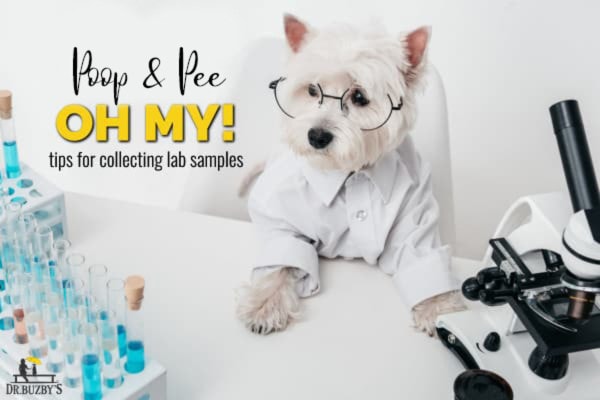
We all know that routine veterinary exams are important to maintain pet health. For most dogs, these annual—or biannual—appointments include some basic lab tests. Depending on your dog’s age and health, tests may include fecal tests, urine tests, and blood work. Your vet may even ask you to bring along a fresh stool sample for testing.
Some pet parents understandably inquire why these tests are important to repeat every year. I certainly understand the question, and am happy to explain that these tests are very important, and that vets wouldn’t recommend them if we didn’t think they were!
So what exactly do these tests tell us, and how can you collect dog urine and poop samples for your vet in a way that maximizes chances of getting reliable results?
In other words, why is your vet asking you to bring a container of poop to your dog’s wellness appointments?
Why do vets need dog fecal samples and urine samples?
Routine screening lab tests like fecal and urine tests help your vet monitor your dog’s health and address issues before they become serious.
Dog fecal samples are not only important for dogs who have GI illness. Some types of parasites can cause sub-clinical infection, meaning your dog won’t show any outward signs of infection. We’ll talk more specifically about parasitic infection below, but I want to point out that incidental parasite eggs are frequently found on fecal tests to illustrate the importance of routine testing.
Similarly, mild signs of early kidney disease, diabetes, and other ailments may not be noticed until the conditions progress. Urine tests can indicate a problem before it becomes too difficult to effectively treat. Testing the dog’s urine in conjunction with blood tests can give crucial information on overall health.
What are the benefits of collecting good fecal and urine samples at home?
You might be surprised to learn that you can play an active role in helping your veterinarian get high-quality diagnostic lab samples from your dog. Fear not, your part doesn’t involve the sight of blood or needles, just a little education.
By knowing what you can do to improve sample quality—including dog poop and pee sample collection and delivery factors—you can:
- Provide your vet with the best stool and urine samples to interpret
- Save time and frustration for you, your dog, and his or her veterinary team
- Avoid the cost of having to repeat tests
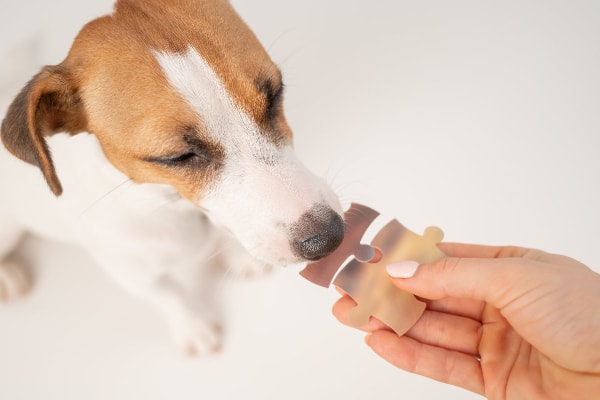
How to get the most out of your dog’s lab tests: 7 helpful tips
As much as I’d like to, a lot of times I’m not able to diagnose my patients with physical exams alone. More often than not, if a dog or cat is sick, we need to run some tests to figure out exactly what’s going on. On occasion, the test results are not as useful for diagnosis as we hoped. Use these seven tips to maximize the chance of your dog’s lab tests giving the most accurate answers possible.
1. Ask your vet’s office if you should bring a stool sample to your dog’s appointment.
We know fecal tests provide important information about your dog’s health, but how do we get the poop to test? Do you need to collect your dog’s stool sample? How does a vet collect a stool sample at the veterinary office? Let’s get to the bottom of these questions.
Dog fecal tests can provide a veterinarian with a lot of information, from the presence of intestinal parasites to certain GI diseases. I consider a fecal test for dogs to be an essential part of routine annual wellness care. I also recommend fecal testing for dogs that are experiencing signs of GI disease, such as diarrhea or vomiting.
What do dog fecal tests tell your vet and you?
Veterinary laboratories have many tests they can run on stool samples, but generally speaking, the term fecal test refers to a fecal flotation test.
A fecal float is a screening test for intestinal parasites, including hookworms, roundworms, whipworms, and tapeworms. Fecal floats can also identify protozoal parasites such as giardia. Many of these parasites are common in dogs, and can cause illness if not treated. Some dog parasites are even zoonotic, meaning they can infect people as well. That’s why it’s super important to make sure your pup is parasite free!
To perform a fecal floatation test, a small amount of stool is added to a little container with a special solution. For some tests, those containers are then placed in a centrifuge. But others allow the “poop soup” to sit for a specific period of time. This allows the fecal material to sink to the bottom of the container, while the parasite eggs are floated to the surface.
Eggs at the top of the fecal solution adhere to a glass slide, and can be seen under a microscope. Your vet can then prescribe parasite treatment if needed. Even if your dog is on consistent prevention, screening for intestinal parasites at least once a year is an important part of his or her preventive healthcare.
If you go to the vet sample-less and they need a dog stool sample for testing, your vet may insert a gloved finger or “fecal loop” instrument into your dog’s rectum to collect fresh feces. While this works, it’s not really ideal—for sample size or for your dog. Instead, ask your vet if they’d like you to bring a dog stool sample in to the appointment.
How much of a dog’s stool is required for testing?
Asking for a fecal sample often doesn’t include specifying quantity. If you’re wondering what size stool sample to bring, here is a rule of thumb:
For dogs, a stool sample the size of a walnut is enough (about a one to two inch sample). For small dogs, this may be their full sample from the morning walk. From larger dogs, just one sizable fecal ball is all that’s needed.

Should you refrigerate your dog’s stool sample?
Once you’ve collected your dog’s stool sample, what do you do with it?
Refrigerating the dog’s stool sample is probably not imperative, but it’s still helpful in a hospital setting, primarily because stool is full of bacteria. Refrigeration helps minimize degradation of the dog’s stool sample. Also, it preserves some of the structures veterinarians look for when running fecal analysis testing. That’s why, in our vet clinic, we refrigerate dog stool samples that are being sent out to the lab.
However, we have a refrigerator dedicated to storing the exciting specimens we handle in veterinary medicine, and it’s against federal regulations for human food to be stored in the same fridge.
If you’re collecting a stool sample from your dog, we generally do NOT recommend that you put your dog’s stool sample in your refrigerator at home.
Dogs can commonly carry parasites that are transmissible to humans via a fecal-oral route. Not to mention the bacteria that’s found in dog feces. If you put your dog’s stool sample in your refrigerator, there’s a (slight) chance that it could accidentally contaminate other food.
The small chance of altering the sample by keeping it at room temperature is simply not worth the risk of possibly contaminating human food.
How long is a dog stool sample good for?
Considering most people don’t have a “poop fridge” at home, you want to try to get the fecal sample to your vet as soon as possible. Room temperature fecal samples are fine for a few (three to five) hours.
When you’re collecting the fecal sample, please make sure you pick it up right after your dog defecates. Bringing in last Monday’s poop from the yard is not going to be good diagnostic quality.
Remember, when it comes to your dog’s stool samples, the fresher the better!
2. Learn how to collect a urine sample from your dog.
You’ve probably seen the signs in your own doctor’s office’s bathroom asking for a “clean, midstream urine sample.” The same philosophy holds true for dogs, too. However, unless you’ve trained your dog to pee in a sterile cup on command, this may be a bit tricky. The tips below can help.
5 tips for collecting your dog’s urine sample
- Collect your dog’s urine in a flat container with a low lip—A deep container is harder to get under your dog. Try using a flat container with a low lip, such as a pie tin. I’ve had some assistants that even collect urine samples using a (dedicated!) ladle. A low profile container is especially important for collecting pee from female dogs, since they tend to squat lower to the ground when they urinate than males.
- Let your dog start going a little bit first—Ideally, you don’t want the first few drops of urine. Instead, let your dog begin urinating for a second before you start collecting. (This is what “midstream” means.) A midstream urine sample is theoretically a “cleaner” sample because the first flow should help flush the outside of your dog’s external urinary tract.
- Be quick and decisive—Some dogs are very private, and don’t want you lingering around their hind end. For these dogs, you typically have one chance to collect a urine sample. Once they figure out that you’re trying to interfere with their private business, they’re done.
- Tape the container to a yardstick or ruler—For the ultra-private canine who won’t let you near for sample collection, you can use duct tape (or similar) to tape the container to a yardstick or ruler. This way you can get the container where it needs to be without you being right on top of your dog and making him or her nervous. The ladle trick is helpful for these dogs, too. Just be careful to keep everything flat as to not spill your dog’s urine sample when you’re pulling it away.
- If possible, have the container lid handy when you collect the sample—It can be so frustrating to finally get a urine sample from a dog with a shy bladder, only to accidentally spill it on the way back inside.
Of course, it also helps if you can keep leaves, grass, and your dog’s muddy paws out of the urine sample, too. This can be easier said than done!
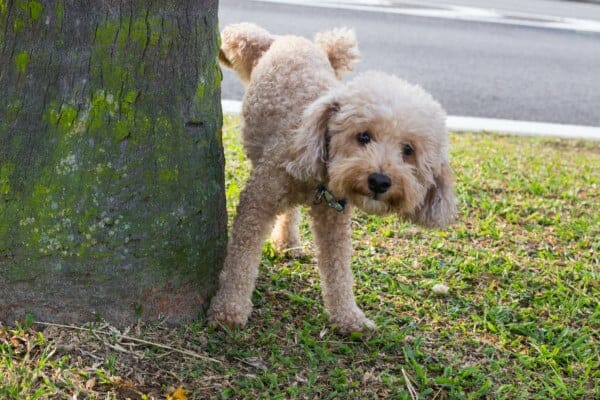
What is the best time of day to collect a dog’s urine sample?
Now that you have a plan for how to collect your dog’s urine for a sample, you may be wondering when to collect it. A first morning urine sample is generally the most concentrated sample of the day since dogs don’t typically drink overnight. (If your dog often drinks overnight, that’s worth discussing with your vet.) While a dog is sleeping, his or her kidneys work to conserve water in the bloodstream and concentrate the urine, which will be voided on the first morning potty break.
If you get a urine sample later in the day, it will likely be more dilute—which may make it harder for your vet to interpret. Might your dog have a problem with his kidneys, or did he just drink a lot of water that day? Obtaining that first morning urine sample allows your vet to get an idea of your dog’s concentrating ability, which is an indicator of kidney function.
Your vet may want a sterile urine sample collected in the office.
Sometimes, your vet may ask for a very fresh urine sample—even one that you or an assistant collect outside the veterinary clinic. Freshness especially matters when evaluating crystals in the urine (crystalluria). Some types of crystals degrade quickly, and other types of crystals can form in stored urine.
Your vet may also choose to collect a sterile urine sample in-house through a process called cystocentesis. It’s basically like an amniocentesis for the dog’s bladder—your vet puts a small needle into the bladder and removes some sterile urine. It may sound scary, but it’s actually quite common and safe. Also, it’s the only practical way to get a sterile urine sample, which is required for some advanced testing. Most dogs tolerate cystocentesis procedures very well.
If your dog is due for lab tests, ask your vet if he or she would like you to collect a first morning urine sample on the day of your appointment.
If possible, schedule a morning vet appointment or drop off your dog’s samples early.
Typically, for routine urinalysis, fresher samples are going to provide the most accurate results. I recommend that my clients collect their dog’s first morning urine sample, put the urine in the refrigerator (keep reading to find out why), and schedule morning veterinary appointments to run lab tests, whenever possible.
If your vet doesn’t need to see your dog—and you’re just dropping off samples—then I definitely recommend dropping off the samples as early as possible. For most tests, the best time to get a urine sample from a dog is first thing in the morning.
How long is a dog pee sample good for?
Your vet will give you guidance (or if you’re not sure, ask!) on what type of urine sample he or she wants. Usually, this is based on what specific urine values your vet is most interested in. Some crystals can form or degrade in under an hour. My general rule of thumb is to analyze the sample within 30 minutes.
Not all of my clients live close to the clinic, and I know life gets crazy, so this often results in collecting urine samples at the vet appointment.
3. Collect an adequate amount of urine for your dog’s urine sample.
“We don’t have enough urine to run the whole urinalysis. What part is most important to you?” Every vet has heard these words from the laboratory. Sometimes the urine sample we’ve been given consists of what appears to be three raindrops of pee.
To avoid this scenario, it’s better to give your vet plenty of urine in a sample than not enough.
As a general guideline, collect at least one tablespoon of your dog’s urine as a sample for routine urine testing.
So while more is always better when it comes to urine, just a tablespoon or two is all your vet really needs to run a urinalysis. (There are 16 tablespoons in a cup if that helps you visualize the volume.)

4. Keep your dog’s urine sample in the refrigerator until your veterinary appointment.
Once you’ve collected your dog’s urine sample, what do you do with it? Keeping your dog’s urine samples cool (by putting them in the refrigerator) will help keep them fresher and yield better results.
Why I recommend refrigerating dog urine samples
Just like we refrigerate food to make it last longer, refrigerating lab samples helps to preserve them. I recommend that clients refrigerate a dog urine sample from the time they collect it until they bring it to the office.
If your vet sends urine to an outside laboratory, he or she will surely refrigerate your dog’s urine sample until the shipping service picks it up. Refrigeration is important because a change in urine pH, proliferation of bacteria, and cellular degeneration can all affect the results. Refrigeration helps to slow these changes.
Although urine samples don’t carry the same risk of zoonotic parasites as fecal samples, we still want to be cautious when putting any bodily fluid in a refrigerator that also stores food. Putting the container of urine inside of a sealed plastic bag and making sure you’re diligent with hand washing will help keep you and your food safe.
5. Ask your vet about running dog urine tests and blood work at the same time.
Now that we have a solid understanding on how to collect your dog’s urine sample, let’s discuss why your vet may want to test urine and blood at the same time. Evaluating your dog’s blood work in light of urinalysis results can help your vet get more breadth and depth of information compared to running blood work alone.
This does not apply for every blood test. (For example, a urinalysis would not be relevant when running a test to check for heartworm disease in dogs.) But it’s beneficial to check your dog’s blood work and urine at the same time to evaluate kidney function, confirm certain metabolic disorders, and screen for urinary tract infection in dogs.
One of the most important pieces of information I get from a urinalysis is the specific gravity, which is basically the concentration of the urine. Urine specific gravity can change with certain diseases or metabolic conditions—such as kidney disease, Cushing’s disease in dogs, etc. But it can also change with hydration. That’s one of the reasons it’s so important to test urine and blood simultaneously. It means your vet can compare the results, and distinguish between a normal change in a healthy dog and something that may be a problem.

6. Bring your dog’s urine or stool sample to your vet’s office in a disposable, clearly marked container.
Once you’ve obtained it, you may be wondering how to bring a urine or stool sample to the vet. I’ve seen dog urine and stool samples delivered to the vet’s office in everything from food take-out boxes to family valuables.
If you think I’m exaggerating, I present the evidence shared by my friend and colleague, Kelsey Carpenter. She started a social media project dedicated to capturing the humor in the containment devices which clients use to transfer their dogs’ stool or urine samples to the vet hospital. Here are a few of my favorites:
Fine glassware (for special occasions)…
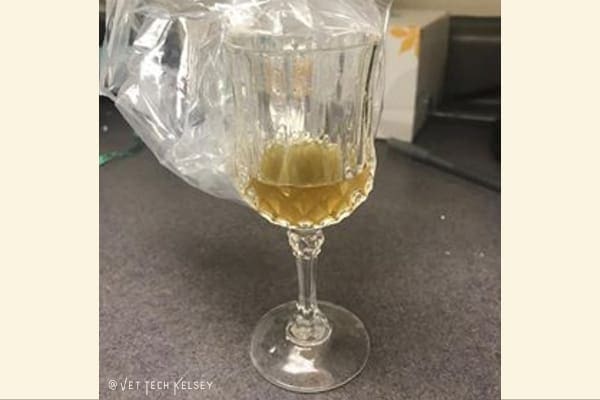
…salsa jars (mild and chunky)…

…and even Panera (special delivery).
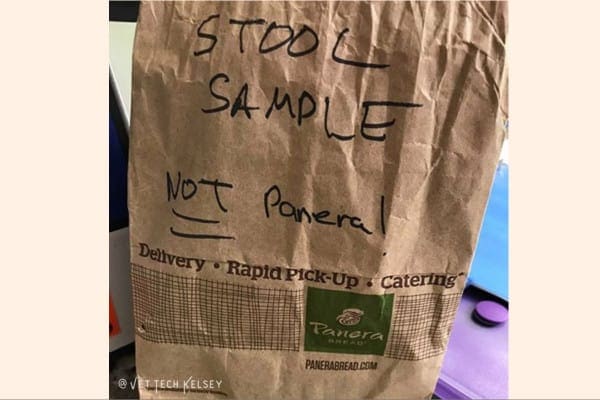
Tips for dog fecal and urine sample storage
While anything goes when it comes to containment devices for your dog’s stool or urine samples, here are some guidelines on how to bring a stool or urine sample to the vet:
- Use something disposable. Trust me, if your dog’s urine or stool was in it, you really don’t want it back. Use something that your vet can throw away once done with it.
- Make sure the container is clean and dry. Any bags or containers should be clean and dry before you put your dog’s samples in them. Moisture and debris can contaminate the sample and interfere with interpretation of the results.
- Ask your vet about a free container for collecting your dog’s urine or stool sample. Your veterinarian should be able to provide you complimentary supplies for sample collection, which are provided to us from our laboratory. These containers are designed to be tidy and efficient. If your vet doesn’t readily offer a container, feel free to ask if they have them available.
- Use glass or plastic for your dog’s urine sample. For collecting your dog’s urine sample, any clean glass or plastic container is fine. Just make sure it is clean and dry and has a lid that seals tightly.
- For your dog’s stool sample, use any container that seals. For dog feces, really any type of container is acceptable. You can use a Ziploc bag or any sort of disposable plastic container. Again, just make sure it seals closed.
- Label any containers with your name and your dog’s name. As much as we try to stay organized, you’ve probably noticed your vet’s office is very busy! Containers are sometimes taken to the lab by the front desk staff and left for the lab technicians without any explanation. Labeling helps ensure that the tech doesn’t mix up your dog’s urine or stool sample with a sample from someone else’s dog, or even accidentally dispose of it. Use a permanent marker to write your dog’s name and your full name on every container you give your vet.
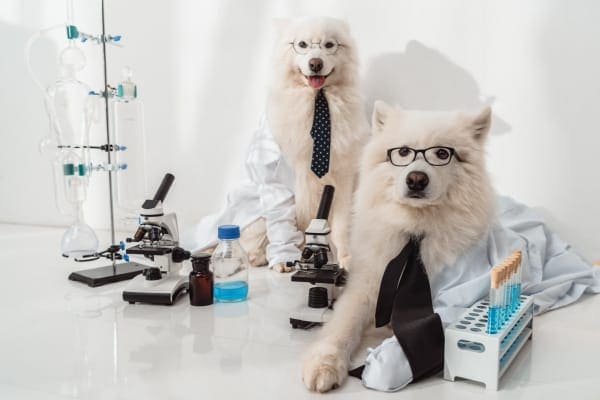
7. Ask your vet for any special instructions prior to your dog’s appointment.
Trust me, I want diagnostic tests to provide answers for your dog as much as you do. To me, every patient is like a puzzle, and a non-diagnostic sample is like finding out you’re missing a puzzle piece after putting the other 999 pieces together.
Some tests have very specific requirements. We want to make sure these instructions are followed as precisely as possible to get the most accurate results.
Some lab tests require fasting. If I need to collect a sterile urine sample, I don’t want that patient peeing right before the appointment. If there is any doubt about what tests your dog needs or what instructions you have for those tests, please ask! It’s as frustrating for your vet as it is for you if diagnostic tests have to be rescheduled over circumstances that could have been avoided. Communication is key!
Dog lab tests are another way to show your dog love
As your dog’s biggest advocate, you now have more tools in your toolkit to help your dog have a happy, successful veterinary visit. By working with your vet, understanding the importance of lab tests, and knowing how to collect dog fecal and urine samples, you’re maximizing the chances that your dog’s lab tests will give you the most accurate answers. And that means you can rest assured that you are doing everything in your power to give your dog the happiest, healthiest life possible.
What questions do you have about collecting fecal and urine samples for your dog’s lab tests?
Please comment below.


To collect a urine sample from my female Golden, I use a flat plastic Rubbermaid or similar container for sandwiches that has a lid. You can find them in them grocery stores and they’re inexpensive. I use grippers — the long pincher like tools older people often use to grab objects that are high or on the ground — to hold the container and that way I don’t have to be standing right next to my dog when she’s trying to go. It’s a lot easier for both of us and it keeps my hands clean.
Hi Mary,
This is great advice! Thank you for sharing your experience with our readers.